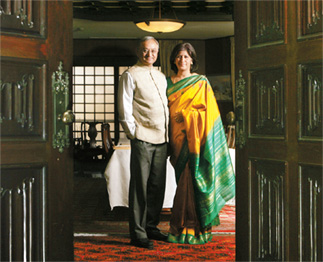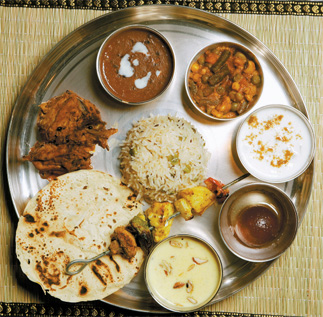[Kitchen Talk]
Spirit and spice at an Indian table

Indian Ambassador Skand R. Tayal and his wife, Kusum. Photos by Jeong Chi-ho
Because human nature feeds on curiosity. It’s how we became what we are today. Our developments and shortcomings are all the result of that particular trait.
Our paper recently ran a series on the potential of Korean cuisine abroad, and one thing that was frequently mentioned by food critics and experts was that food needed to be viewed as a comprehensive package. The overall atmosphere of the venue where the food is served plays as much of a role as the quality of the food itself.
So I was genuinely pleased when I went to Indian Ambassador Skand R. Tayal’s residency in Itaewon-dong. From the outside, the residency was just a plain house but its interior really struck a note.

Basmati rice with a variety of accompanying dishes.
I was actually looking forward to this encounter because Indian cuisine is no stranger to the Korean palate. There are plenty of Indian restaurants here that have been around for quite some time. So naturally there was no angst on my part of running into some exotic food that I had to be polite about.
But I also knew that real Indian cuisine would taste different as what we get here is heavily localized. I went to Singapore last year and the Indian curry that I had there was a world away from anything I had already tasted.
So I was prepared to explore. Also, the fact that the ambassador and his wife are both vegetarian made the visit more intriguing.
That is probably also why bibimbap was singled out by both of them as their favorite Korean dish without being asked.
“Bibimbap is very nice and there are so many vegetable side dishes. Very healthy food,” said Mrs. Tayal. For the ambassador, who has always been vegetarian, bibimbap without the customary beef and spiced up with chili pepper sauce is a treat.
India’s various religious and cultural backgrounds make it a melting pot of many things, and have certainly influenced how Indian cuisine is presented.
The meal that I had was centered around basmati rice, which is different from the rice in this region. It is longer grained and also carries a distinctive flavor. But the highlights were the various accompanying dishes. To name a few there was curry sauce with lotus seeds and a yogurt-based raita paste served cold. Just for me, there was also chicken. Naan bread served as a substitute for the rice. There were also samosas, a pastry snack filled with potatoes served with mint and tamarind paste.
Being able to select from many dishes is probably the strongest attraction of Indian cuisine. It offers varieties and combinations that can be tailored to one’s liking.
Indians who are accustomed to it may not notice it, but the aroma drifting around the table from the dishes’ spices was spellbinding for someone like me.
The effect was that my whole body reacted to the food experience as I was engulfed by the almost mystical smells. It was like having more food, the only difference being that it was absorbed with my nose.
“Indian cuisine differs from region to region. Mostly what you find here is from the northern region,” said Ambassador Tayal as he explained how spices like black pepper played a crucial role from the beginning of India’s history.
Dessert was a sweet dish called gulab zamun made of dough. There was also rice pudding delicately flavored with saffron. The conclusion was Indian masala tea with mint.
Touching upon subjects other than culture, I asked the ambassador how much progress has been made toward getting Indian English teachers here. The Korean government relaxed requirements for English teachers last year to also include those for whom English is not their first language but still is an official language of the country.
Pointing out that all of India’s higher education is in English, he said, “We have a certain capacity in English learning and teaching. We only want qualified English teachers to come so there should be a testing mechanism.”
The ambassador predicted that in the second half of this year some tangible progress will be made. He envisioned a system in which a Korean agency in charge of identifying schools in need would be working with certified Indian agencies that would test candidates and match them with the agency.
Despite the global economic downturn, Ambassador Tayal was also optimistic on bilateral trade relations as he sees a demand for Korean companies to work on projects to improve his country’s infrastructure, such as airports and roads.
When I think of India it’s a faraway country, but for reasons I don’t know it occupies a certain place in my mind that I intend to fill someday by going there.
Perhaps because it was the birthplace of an ancient civilization. Perhaps because images of the Taj Mahal are so deeply embedded in my head, India has always captured my imagination. But a unique meal is probably the best catalyst for any foreigner to build interest. In that sense, Indian cuisine scores big.
By Brian Lee Staff Reporter [africanu@joongang.co.kr]
Indian Ambassador Skand R. Tayal and his wife, Kusum. Photos by Jeong Chi-ho










with the Korea JoongAng Daily
To write comments, please log in to one of the accounts.
Standards Board Policy (0/250자)